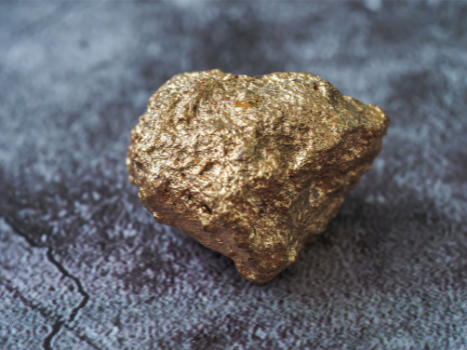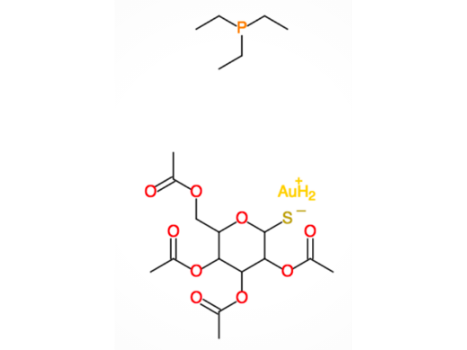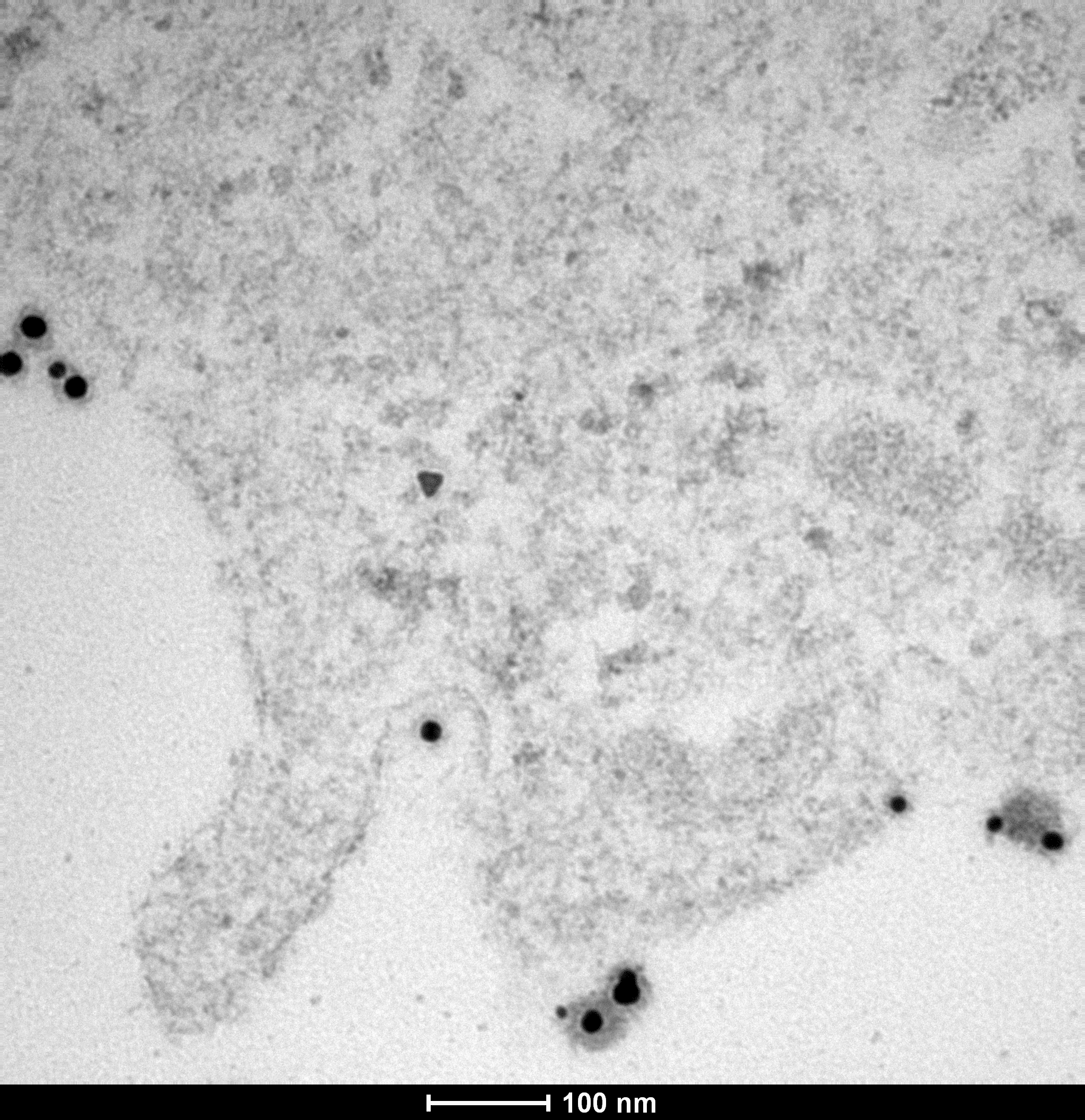The history of gold usage in medicine
Since its discovery, people have thought of gold as having an immortal nature because of its resistance to corrosion and oxidation. Therefore, gold was first used to seek for longevity in many ancient cultures in India, Egypt, and China. The first evidence of gold to cure sickness dates back to 2500 BC in China. Then, gold was widely used by ancient Chinese physicians and surgeons, especially in case of fever, measles or infection in general (1). In the western world, gold was also deified for the link it could have with the warm life-giving light of sun.

Gold ore | Credits: Aree Chitprasartchai
Gold in modern rational medicine
Robert Koch (1843-1910) is one of the greatest biologists of his time. He received the Nobel prize of medicine in 1905 for his research on tuberculosis (he discovered the causative agent of this disease). He is also known for the creation of “Koch’s postulate” which is still used to link a pathogen to a disease. He is considered as one of the fathers of modern medicine along with Louis Pasteur and Joseph Lister. During his work on M. Tuberculosis, in 1880, Robert Koch discovered that gold cyanide, K[Au(CN)2], was bacteriostatic towards this agent of tuberculosis. Back then, no treatment existed for tuberculosis and therefore, within a span of 10 to 15 years, the whole world used gold as the golden standard to treat tuberculosis. The (wrong) suggestion that the same agent could be responsible of rheumatoid arthritis led to the use of gold therapy also for this disease. Jacques Forestier, a French physician, was the first person to report it in 1928. He treated his patient with 50 mg of gold thiopropanol sodium sulphonate (Allochrysine) as weekly intramuscular injections (3).
Gold therapy soon proved to be actually ineffective against tuberculosis. After 30-years of debate about the effectiveness of gold therapy in rheumatoid arthritis treatment and a clinical study sponsored by the Empire Rheumatism Council, it was finally reported in 1961, that gold therapy is effective against this disease (4).
At present, besides allochrysine which is still administered intra-muscularly, another drug receives the FDA approval for the treatment of rheumatoid arthritis, Auranofin. Auranofin has been approved in 1985. It is an oral drug to be taken twice a day. Research about the use of gold in medicine is on-going. As an example, it has been shown very recently that Auranofin is able to inhibit Sars-CoV-2 replication and to attenuate inflammation in human cells (5).

Chemical formula of Auranofin
A new use of gold in medicine
Except those previously described, there is almost no gold-containing drugs available in the market. Especially since Turkevich’s work on gold nanoparticles, a tremendous amount of work is performed to apply the wonderful abilities of these nanoparticles in clinic.
In our society, nanoparticles have an unfair reputation as they are generally considered as pollution and toxic. It is true that unwanted nanoparticles coming from automobiles and big industries release in the atmosphere is bad for both our environment and our health. Due to their small size (in the same range of a virus), nanoparticles can penetrate the human body, organs, and cells and have an impact on them. But the exact same property when mastered and well optimized make these nanoparticles great tools to target, visualize and treat diseases.
Therefore, many labs work on nanoparticles, and especially gold nanoparticles, which are highly biocompatible. Due to their optical, electronic, and molecular-recognition properties, gold nanoparticles can be used for different functionalities by turning them into a tool named nanotheranostics (nanoparticles designed for therapy and diagnostic).
The first step to treat a disease is first to diagnose the patient. In that goal, gold nanoparticles have recently gained attention as an x-ray contrast agent due to their high x-ray attenuation as well as their easy surface functionalization. Especially that there is almost no new improvements in clinical x-ray contrast agent in the last 25 years. The chemical platform is still the tri-iodobenzene with its known limitations (short imaging time, need for catheterization in many cases, occasional renal toxicity, and poor contrast power in large patients). Gold nanoparticles may overcome these limitations (6).
To our knowledge, no gold nanoparticles is used as a contrast agent in clinic yet. In NT1 project, our goal is to combine this contrast agent property to better visualize the skin tumor as well as confirm the internalization of our product before applying a Near Infrared Laser (see photothermal therapy) to heat the tumor.

TORSKAL’s Gold Nanoparticles synthesized from green chemistry, lyophilised plant extract, plant powder and dried plant leaves
Gold nanoparticles are easy to functionalize with peptide or antibody permitting a targeting of specific organs or cells making them already good putative drug carrier. Furthermore, transport of gold nanoparticles to tumor tissues is facilitated by the enhanced permeability and retention (EPR) effect. It is a characteristic phenomenon of solid tumors. To feed efficiently, the tumor tissue with the high amount of nutrient and oxygen is needed as the new blood vessels are rapidly formed and are “leaky”, inducing an accumulation of blood in the tumor, macromolecules and nanoparticles if intravenously injected (7).
Three clinical trials, using gold nanoparticles as a drug carrier are reported on the clinical trials website. Two clinical trials started in 2006 with CYT-6091, a 27nm-gold nanosphere carrying the tumor necrosis factor (TNF) to treat advanced solid tumors (NCT00356980) and solid cancer primary or metastatic (NCT00436410). These two trials show an apparent good distribution of TNF in the tumor (8). The second “drug-nanoparticle” tested in clinic is NU-0129. It is a gold nanosphere carrying a fragment of RNA targeting Bcl2L12 gene (associated with tumor growth) in recurrent glioblastoma and gliosarcoma. The clinical trial started in 2017 (NCT03020017) and, once again, a good distribution to tumors was observed (9).
Radiotherapy is one of the main tools in the fight against cancer. While it is highly effective to kill tumor cells, there is collateral damage against close-by healthy cells. In general, the use of radio-enhancers will permit to boost effectively the killing of tumor cells with a lower amount of radiation, and therefore a decrease of collateral damage. Among the putative radio-enhancer, gold nanoparticles are of particular interest because of gold’s high atomic number (10). In our NT2 – Deep Cancer Project, we are optimizing our product to be an efficient radio-enhancer that will be used in deep cancers.
Photothermal therapy (PTT) is a local medical treatment consisting of a chemical “platform” (here gold nanoparticles) which will heat when combined with a specific phototherapy Near Infrared Laser (NIR). A 7°C temperature increase is enough to kill tumor cells as both NIR laser and gold nanoparticles are inert alone. This therapy has the great advantage of double targeting, permitting, in theory, a decrease of adverse events. That is why, PTT is the main therapy using gold nanoparticles reported on the clinical trials website.
Nanospectra sponsored 4 clinical trials using their Auroshell as a platform for PTT to treat lung cancer (NCT01679470), head and neck tumors (NCT00848042) and neoplasms of the prostate (NCT02680535; NCT04240639). PTT using hybrid gold nanoparticles (gold-silica nanoparticle) was also tested for other diseases, like artherosclerosis (NCT01270139; NCT01436123) or acne (NCT02219074; NCT02217228; NCT02758041; NCT03303170; NCT03573115; NCT03818555) 11. Finally, this silica-gold platform was FDA approved. Our NT1 product will soon reach the clinical trial (by the end of 2021) in the treatment of skin cancer by the combination of,
- Intratumoral injection of our product
- X-ray imaging of our product to perfectly define the tumor
- NIR laser irradiation to “burn” tumor cells with a minimum collateral damage

Our gold nanoparticles entering a melanoma cell
The most advanced gold nanoparticles acting actually as a direct drug is CNM-Au8, a gold nanocrystal designed by Clene Nanomedecine. Usually, gold nanoparticles are synthetized by reduction of gold salts. On the contrary, CNM-Au8 was synthetized through an electro-crystallization-based method. This gives a unique catalytic activity to CNM-Au8. Seven phase II clinical trials are on-going mainly on neurodegenerative disorders: Relapsing Remitting Multiple Sclerosis (NCT03993171), Parkinson’s Disease (NCT03815916; NCT03536559), Amyotrophic Lateral Sclerosis (ALS) (NCT03843710; NCT04081714; NCT04098406; NCT04297683) and the US FDA granted CNM-Au8 with the orphan drug status for the treatment of ALS in July 2019.
